Dynamic Response Characteristics of Roadway Surrounding Rock and the Support System and Rock Burst Prevention Technology for Coal Mines
Abstract
1. Introduction
2. Engineering Background
2.1. Project Profile
2.2. Roadway Failure Characteristics
3. Dynamic Response Characteristics of Roadway Surrounding Rock and the Support System
3.1. Numerical Model
3.2. Dynamic Response Characteristics of the Surrounding Rock
3.3. Dynamic Response Characteristics of the Support System
4. Roadway Rock Burst Prevention and Support Technology
4.1. Proposed Support System for Rock Burst Prevention
4.2. Performance of the Support System
5. Conclusions
- (1)
- The propagation of the dynamic shock stress wave was divided into a stress vibration initiation stage, a stress fluctuation stage, and a stress adjustment stage. In the stress vibration initiation stage, the stress wave was transmitted to the surface of the roadway, causing the surface mass of the surrounding rock to start to vibrate; in the stress fluctuation stage, the dynamic stress wave acted on the roadway surface to produce tensile and compressive stresses, and the surrounding rock failed severely; and in the stress adjustment stage, the residual dynamic stress wave attenuated inside the surrounding rock, which tended to stabilize.
- (2)
- As the dynamic shock intensity increased, the vibration velocity, displacement increment, and acceleration amplitude of the roadway surrounding the rock mass increased exponentially. The critical shock energy was 105 J, above which the dynamic responses of the roadway surrounding the rock became significant.
- (3)
- In the stress vibration initiation stage, the pretension of the anchor cables (bolts) was reduced, and their axial forces decreased; in the stress fluctuation stage, the axial forces of the anchor cables (bolts) fluctuated periodically, resulting in damage being made to them; and in the stress adjustment stage, the axial forces of the anchor cables (bolts) tended to be stable. The damage to the anchor cables (bolts) increased when the direction of the shock source was parallel to the axial direction of the anchor cables (bolts); the higher the shock intensity and pretension were, the more severe the damage to the anchor cables (bolts) was.
- (4)
- Based on the dynamic response characteristics of the roadway surrounding the rock and the support system under the dynamic shock, a full anchor cable yielding support technology was used to reduce the depth of the fractures developed in the roadway surrounding rock by 51.75–61.32% and the deformation of the surrounding rock by 52.61–76.91%, thereby significantly enhancing the stability of the roadway surrounding the rock.
Author Contributions
Funding
Data Availability Statement
Conflicts of Interest
References
- Xu, L.M.; Lu, K.X.; Pan, Y.S.; Qin, Z.J. Study on rock burst characteristics of coal mine roadway in China. Energ. Source. Part A Recover. Util. Environ. Eff. 2022, 44, 3016–3035. [Google Scholar] [CrossRef]
- Zhang, M.; Jiang, F.X. Rock burst criteria and control based on an abutment-stress-transfer model in deep coal roadways. Energy Sci. Eng. 2020, 8, 2966–2975. [Google Scholar] [CrossRef]
- Qi, Q.X.; Li, Y.Z.; Zhao, S.K.; Zhang, B.Z.; Zheng, W.C.; Li, H.T.; Li, H.Y. Seventy years development of coal mine rockburst in China:establishment and consideration of theory and technology system. Coal Sci. Technol. 2019, 47, 1–40. [Google Scholar]
- Cook, N.G.W.; Hoek, E.; Pretorius, J.P.G. Rock mechanics applied to the study of rockbursts. J. S. Afr. I. Min. Metall. 1965, 66, 436–528. [Google Scholar]
- Cai, W.; Dou, L.M.; Zhang, M.; Cao, W.Z.; Shi, J.Q.; Feng, L.F. A fuzzy comprehensive evaluation methodology for rock burst forecasting using microseismic monitoring. Tunn. Undergr. Space Technol. 2018, 80, 232–245. [Google Scholar] [CrossRef]
- Dou, L.M.; He, J.; Cao, A.Y.; Gong, S.Y.; Cai, W. Rock burst prevention methods based on theory of dynamic and static combined load induced in coal mine. J. China Coal Soc. 2015, 40, 1469–1476. [Google Scholar]
- Li, H.T.; Qi, Q.X.; Du, W.S.; Li, X.P. A criterion of rockburst in coal mines considering the influence of working face mining velocity. Geomech. Geophys. Geo. 2022, 8, 37. [Google Scholar] [CrossRef]
- Li, H.T.; Qi, Q.X.; Zhao, S.K.; Li, H.Y.; Shu, L.Y.; Chen, L.Q. Three Factors mechanism of coal mine dynamic disaster. Coal Sci. Technol. 2021, 49, 42–52. [Google Scholar]
- Pan, J.F.; Ning, Y.; Qin, Z.H.; Wang, S.W.; Xia, Y.X. Dredging technology of pressure with deep hole interval blasting based on theory of rock burst start-up. Chin. J. Rock Mech. Eng. 2012, 31, 1414–1421. [Google Scholar]
- Liu, H.; Yu, B.; Liu, J.R.; Wang, T.X. Investigation of impact rock burst induced by energy released from hard rock fractures. Arab. J. Geosci. 2019, 12, 381. [Google Scholar] [CrossRef]
- Xiao, Z.M.; Liu, J.; Gu, S.T.; Liu, M.Q.; Zhao, F.T.; Wang, Y.; Ou, C.; Zhen, M.Y. A Control Method of Rock Burst for Dynamic Roadway Floor in Deep Mining Mine. Shock Vib. 2019, 2019, 7938491. [Google Scholar] [CrossRef]
- Yang, Y.S.; Wei, S.J.; Li, K. Inverse analysis of dynamic failure characteristics of roadway surrounding rock under rock burst. Energy Sci. Eng. 2021, 9, 2298–2310. [Google Scholar] [CrossRef]
- He, J.; Dou, L.M.; Mu, Z.L.; Cao, A.Y.; Gong, S.Y. Numerical simulation study on hard-thick roof inducing rock burst in coal mine. J. Central South Univ. 2016, 23, 2314–2320. [Google Scholar] [CrossRef]
- Zhang, J.F.; Jiang, F.X.; Yang, J.B.; Bai, W.S.; Zhang, L. Rockburst mechanism in soft coal seam within deep coal mines. Int. J. Min. Sci. Technol. 2017, 27, 551–556. [Google Scholar] [CrossRef]
- Gao, H.; Zhao, W.S.; Chen, W.Z.; Xie, P.Y.; Zhong, K.; Qin, C.K. Continuous three-dimensional stress monitoring in roof of coal mines for investigating the rockburst control effect with hydraulic fracturing. Environ. Earth Sci. 2022, 81, 433. [Google Scholar] [CrossRef]
- Gu, S.T.; Chen, C.P.; Jiang, B.Y.; Ding, K.; Xiao, H.J. Study on the Pressure Relief Mechanism and Engineering Application of Segmented Enlarged-Diameter Boreholes. Sustainability 2021, 14, 5234. [Google Scholar] [CrossRef]
- Xu, D.; Gao, M.S.; Zhao, Y.C.; He, Y.L.; Yu, X. Study on the Mechanical Properties of Coal Weakened by Acidic and Alkaline Solutions. Adv. Civ. Eng. 2020, 2020, 8886380. [Google Scholar]
- Lan, T.W.; Fan, C.J.; Han, J.; Zhang, H.W.; Sun, J.W. Controlling Mechanism of Rock Burst by CO2 Fracturing Blasting Based on Rock Burst System. Shock Vib. 2020, 2020, 8876905. [Google Scholar] [CrossRef]
- Yan, P.; Zhao, Z.G.; Lu, W.B.; Fan, Y.; Chen, X.R.; Shan, Z.G. Mitigation of rock burst events by blasting techniques during deep-tunnel excavation. Eng. Geol. 2015, 188, 126–136. [Google Scholar] [CrossRef]
- Zhou, X.X.; Ouyang, Z.H.; Zhou, R.R.; Ji, Z.X.; Yi, H.Y.; Tang, Z.Y.; Chang, B.; Yang, C.C.; Sun, B.C. An Approach to Dynamic Disaster Prevention in Strong Rock Burst Coal Seam under Multi-Aquifers: A Case Study of Tingnan Coal Mine. Energies 2021, 14, 7287. [Google Scholar] [CrossRef]
- Zhao, T.B.; Guo, W.Y.; Yu, F.H.; Tan, Y.L.; Huang, B.; Hu, S.C. Numerical Investigation of Influences of Drilling Arrangements on the Mechanical Behavior and Energy Evolution of Coal Models. Adv. Civ. Eng. 2018, 2018, 3817397. [Google Scholar] [CrossRef]
- Gong, F.Q.; He, Z.C.; Jiang, Q. Internal Mechanism of Reducing Rockburst Proneness of Rock Under High Stress by Real-Time Drilling Pressure Relief. Rock Mech. Rock Eng. 2022, 55, 5063–5081. [Google Scholar] [CrossRef]
- Cai, X.; Cheng, C.Q.; Zhou, Z.L.; Konietzky, H.; Song, Z.Y.; Wang, S.F. Rock mass watering for rock-burst prevention: Some thoughts on the mechanisms deduced from laboratory results. Bull. Eng. Geol. Environ. 2021, 80, 8725–8743. [Google Scholar] [CrossRef]
- Song, D.Z.; Wang, E.Y.; Liu, Z.T.; Liu, X.F.; Shen, R.X. Numerical simulation of rock-burst relief and prevention by water-jet cutting. Int. J. Rock Mech. Min. Sci. 2014, 70, 318–331. [Google Scholar] [CrossRef]
- Guo, D.M.; Kang, X.C.; Lu, Z.Y.; Chen, Q.Y. Mechanism and Control of Roadway Floor Rock Burst Induced by High Horizontal Stress. Shock Vib. 2021, 2021, 6745930. [Google Scholar] [CrossRef]
- Zhang, H.; Zhu, Y.M.; Chen, L.; Hu, W.D.; Chen, S.G. The Prevention and Control Mechanism of Rockburst Hazards and Its Application in the Construction of a Deeply Buried Tunnel. Appl. Sci. 2019, 9, 3629. [Google Scholar] [CrossRef]
- Guo, W.Y.; Zhao, T.B.; Tan, Y.L.; Yu, F.H.; Hu, S.C.; Yang, F.Q. Progressive mitigation method of rock bursts under complicated geological conditions. Int. J. Rock Mech. Min. Sci. 2017, 96, 11–22. [Google Scholar] [CrossRef]
- Sun, Y.H.; Zhang, X.H.; Xu, H.H. Research on Rock Burst Control Mechanism of Deep Buried Tunnel Using Surrounding Rock Modification Theory. Shock Vib. 2022, 2022, 5057665. [Google Scholar] [CrossRef]
- Yan, H.; He, F.L.; Li, L.Y.; Feng, R.M.; Xing, P.F. Control mechanism of a cable truss system for stability of roadways within thick coal seams. J. Central South. Univ. 2017, 24, 1098–1110. [Google Scholar] [CrossRef]
- Gao, M.S.; He, Y.L.; Xu, D.; Yu, X. A New Theoretical Model of Rock Burst-Prone Roadway Support and Its Application. Geofluids 2021, 2021, 5549875. [Google Scholar] [CrossRef]
- Jiang, B.; Wang, Q.; Li, S.C.; Ren, Y.X.; Zhang, R.X.; Wang, H.T.; Zhang, B.; Pan, R.; Shao, X. The research of design method for anchor cables applied to cavern roof in water-rich strata based on upper-bound theory. Tunn. Undergr. Space Technol. 2016, 53, 120–127. [Google Scholar] [CrossRef]
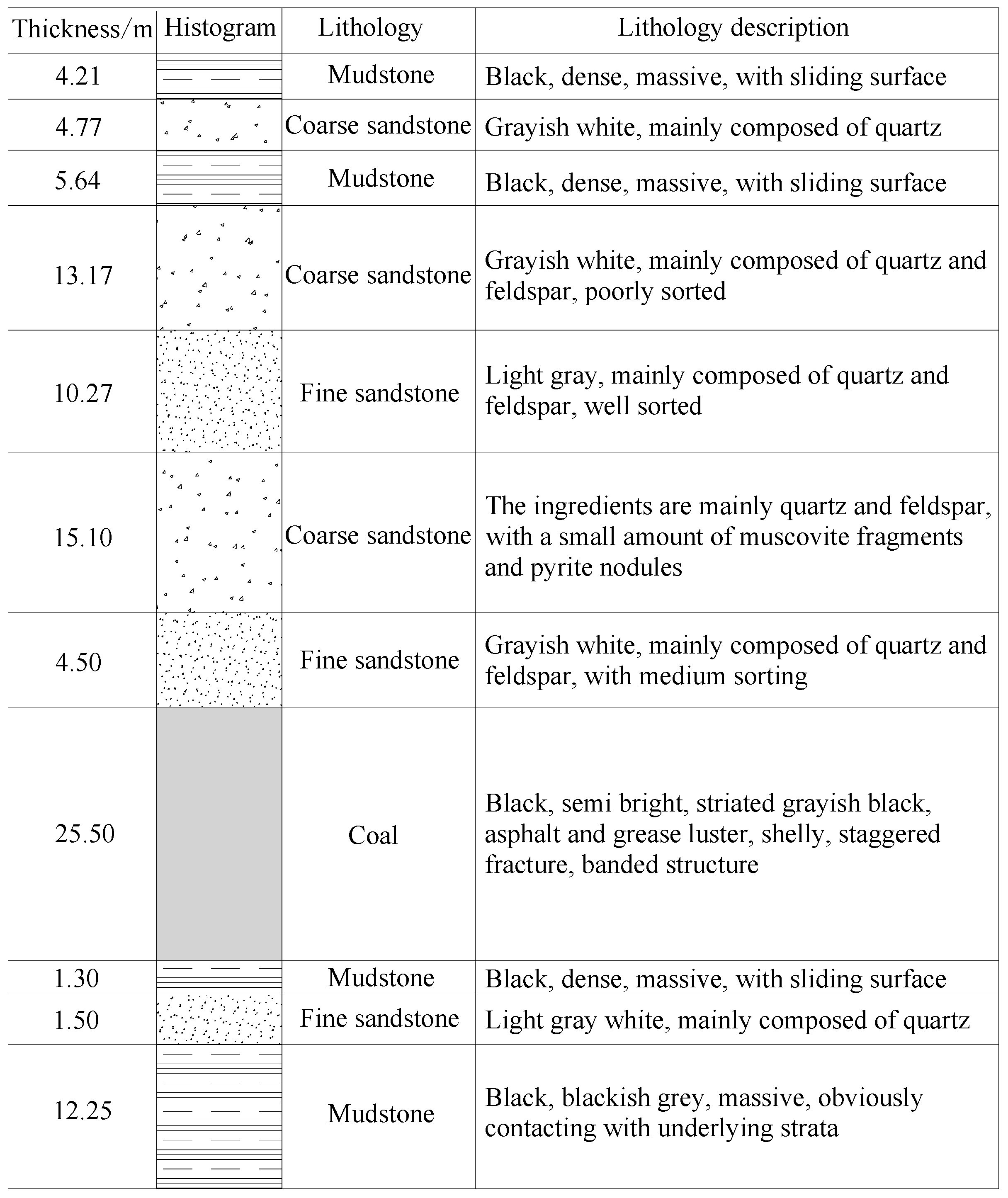
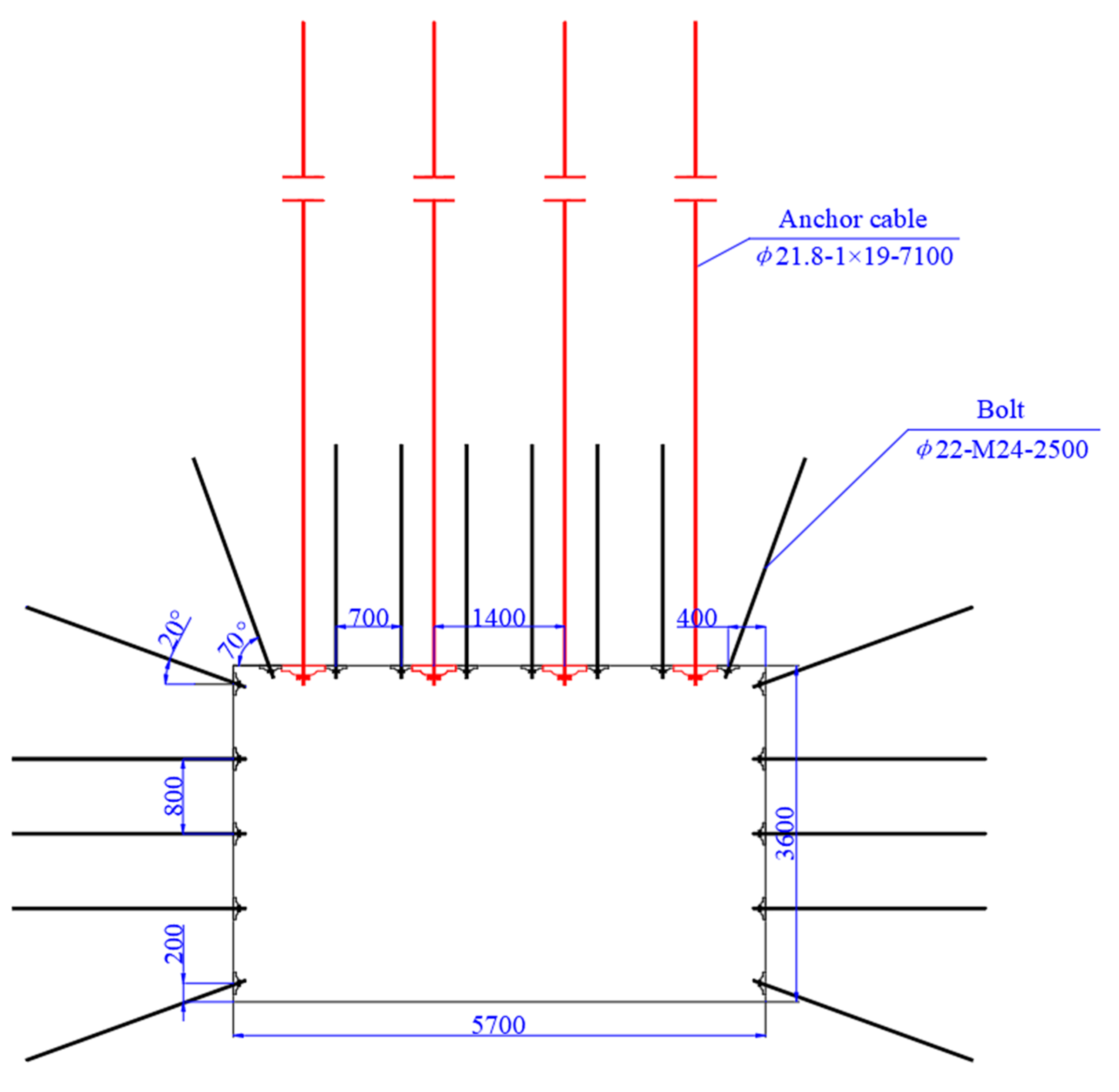
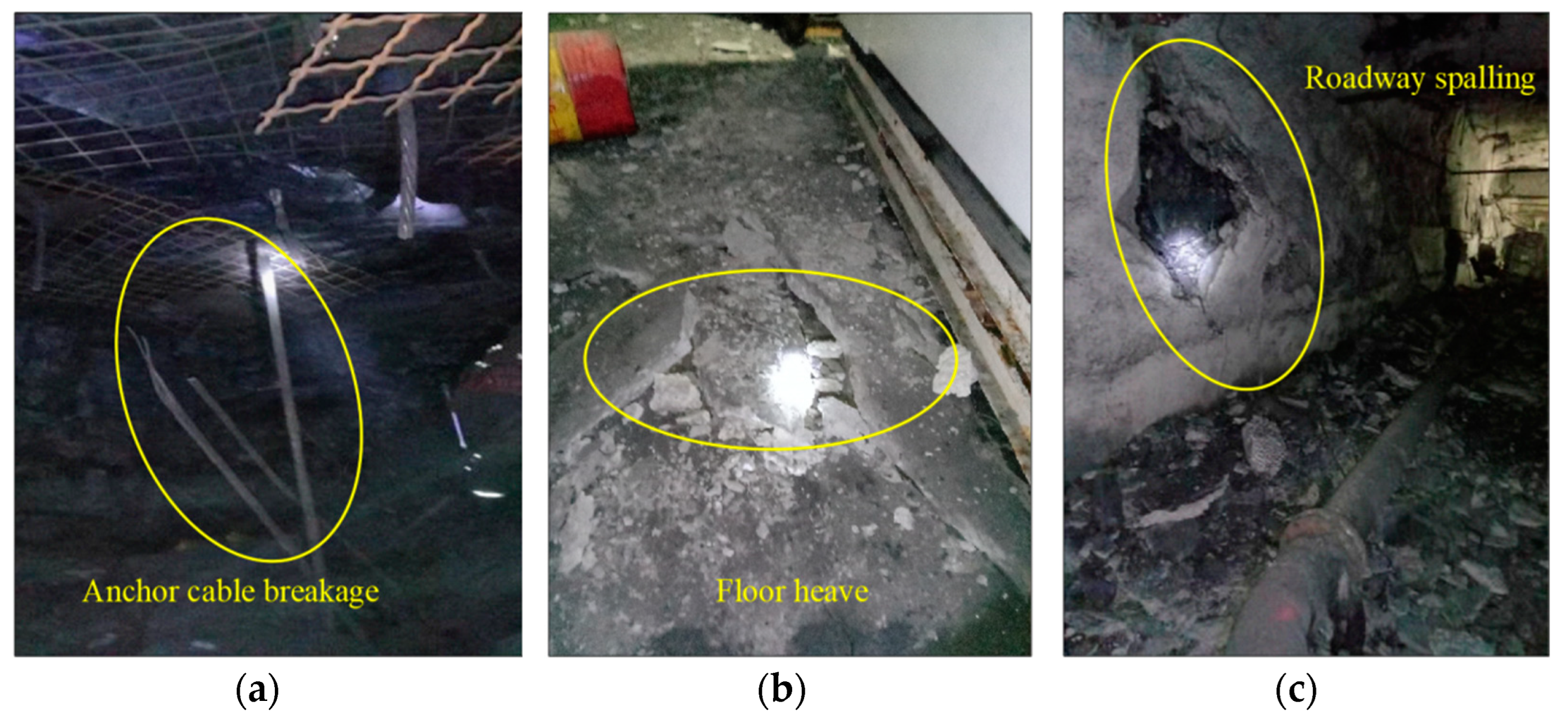

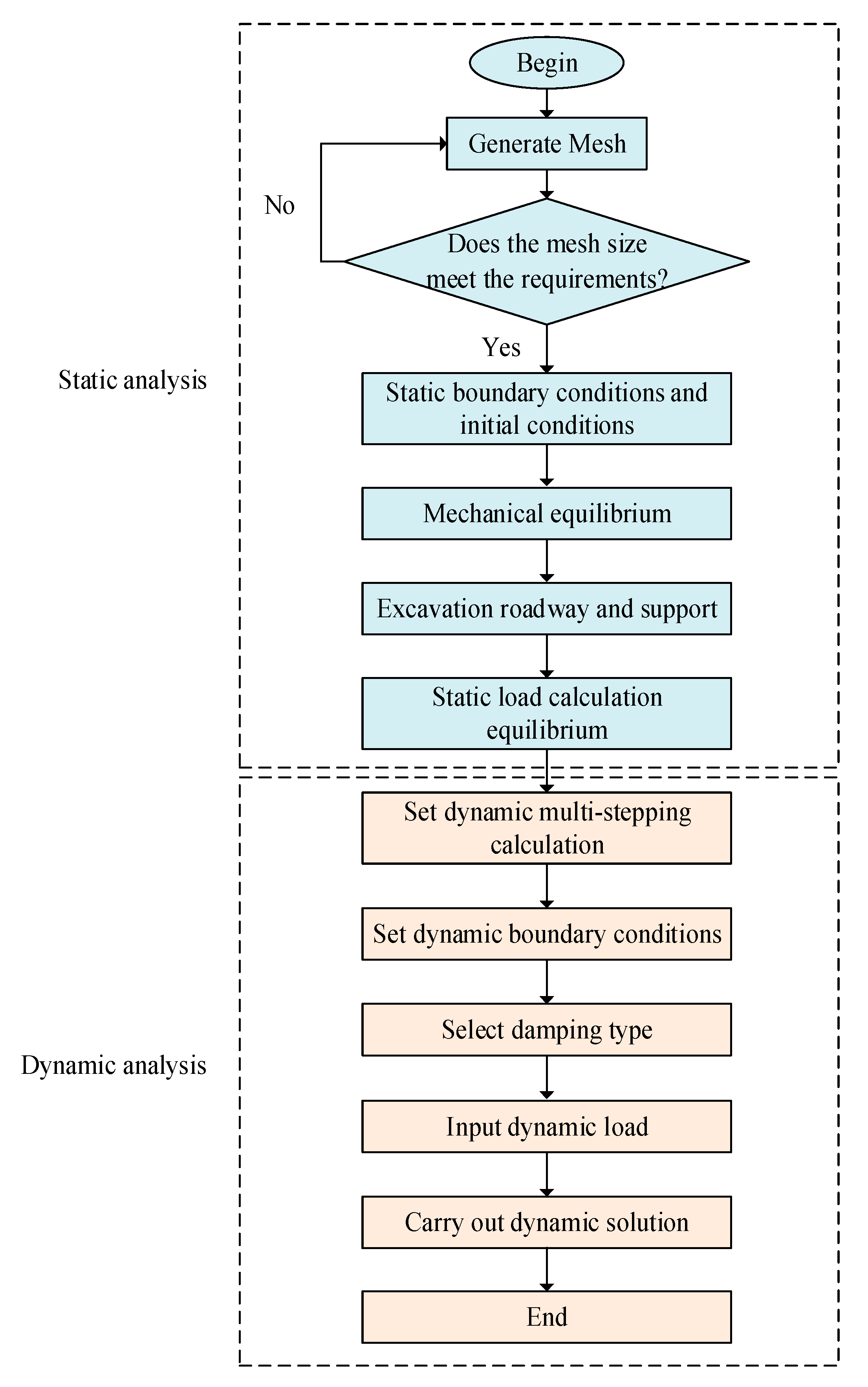
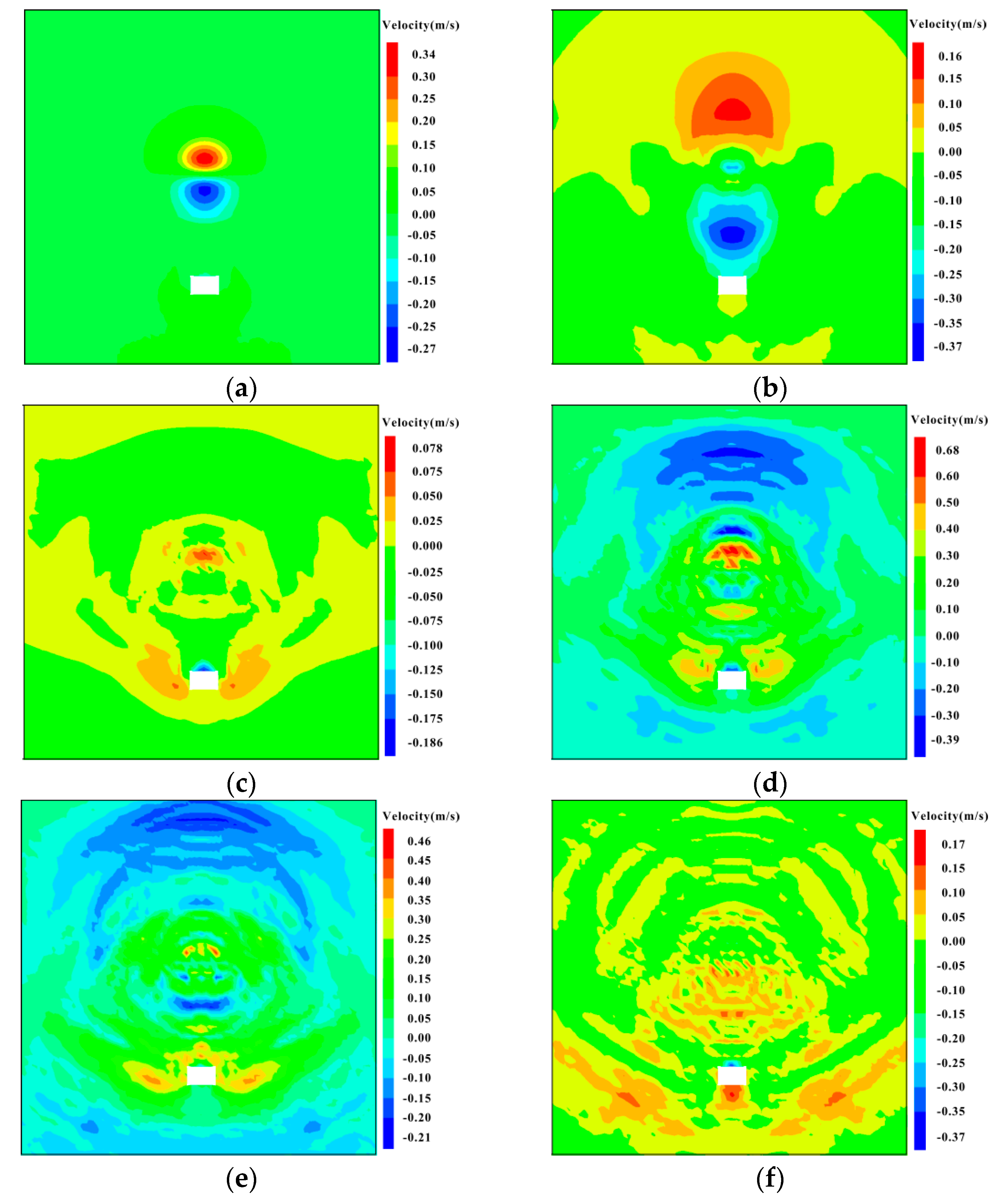
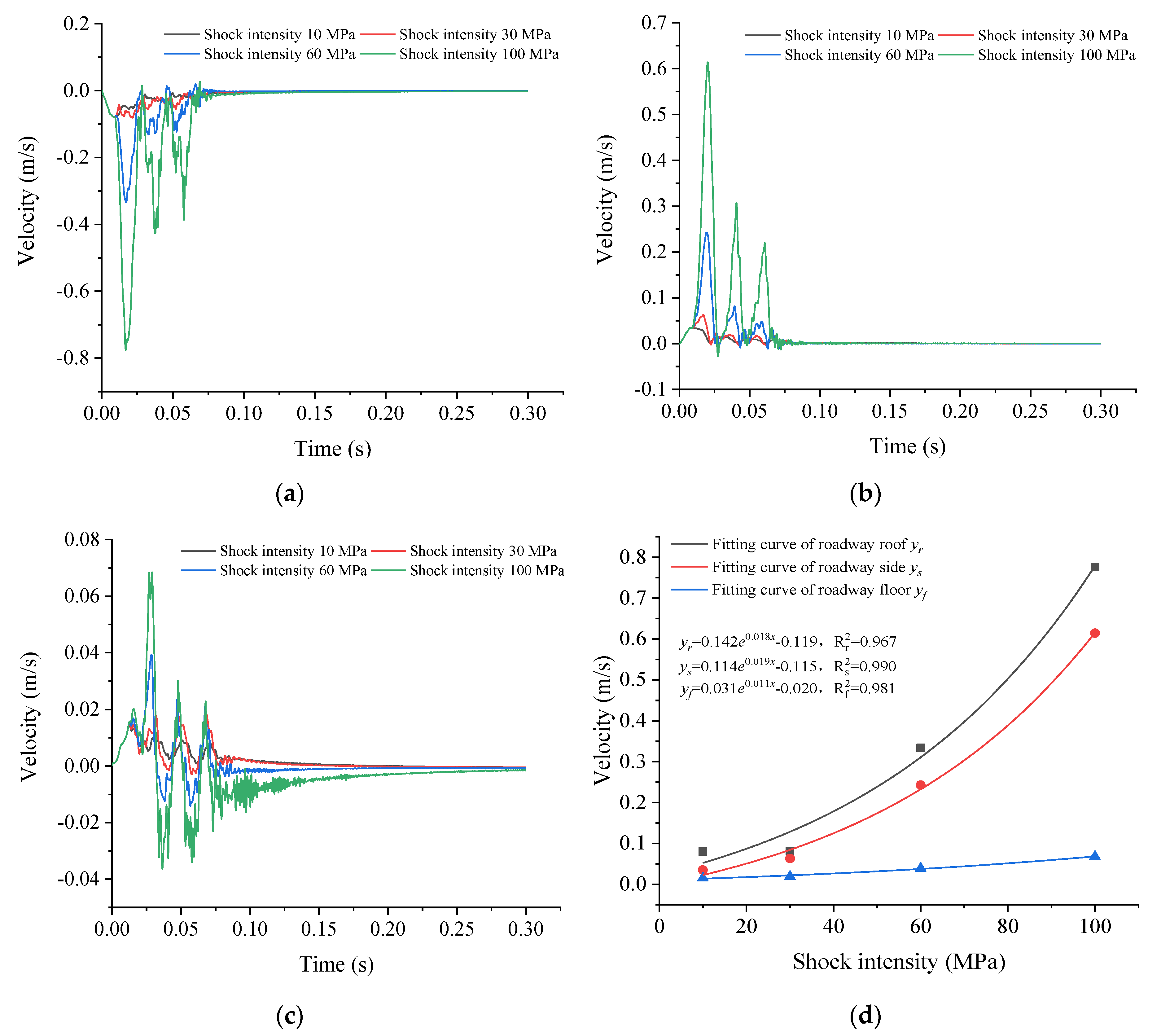
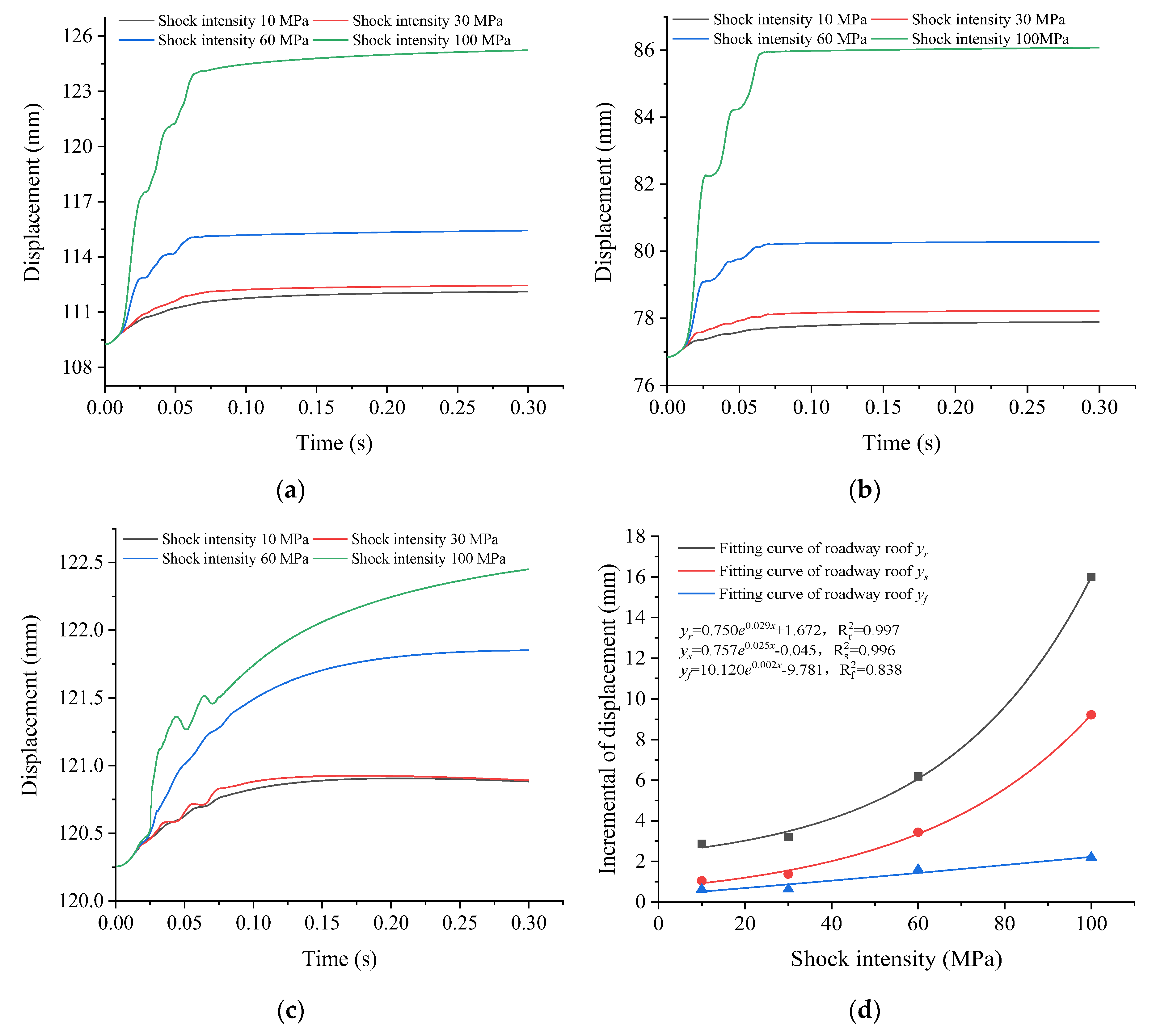
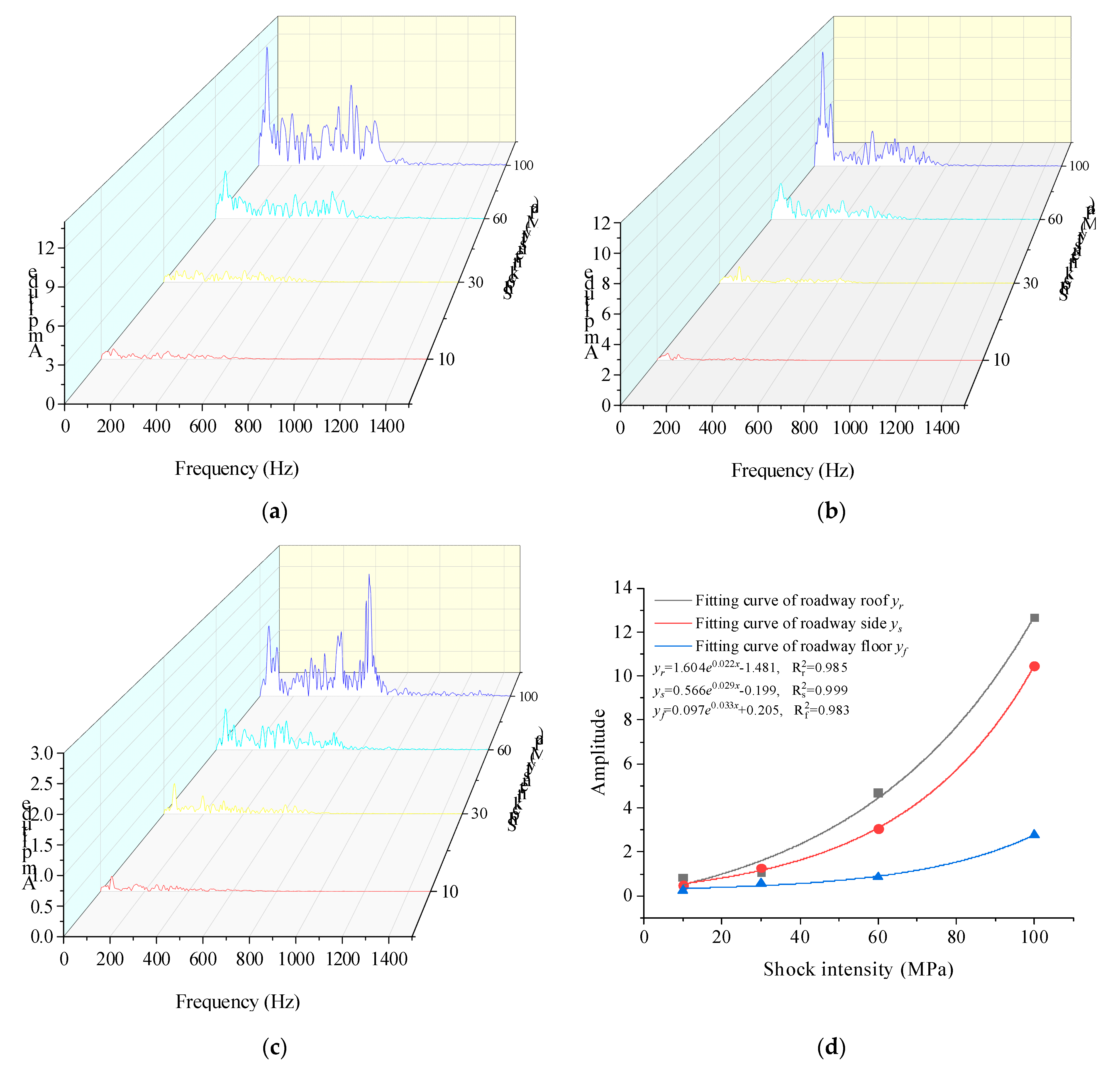
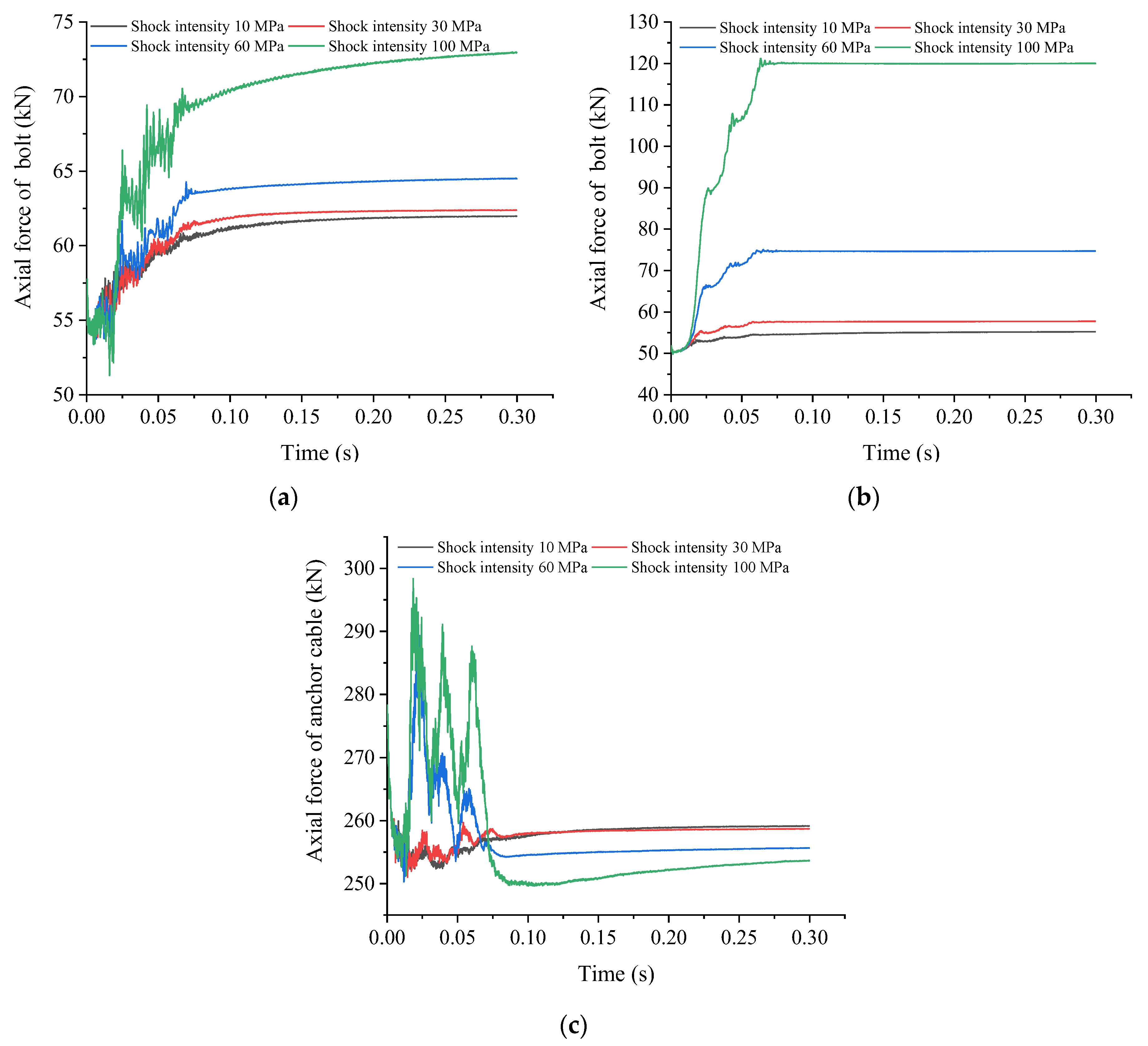

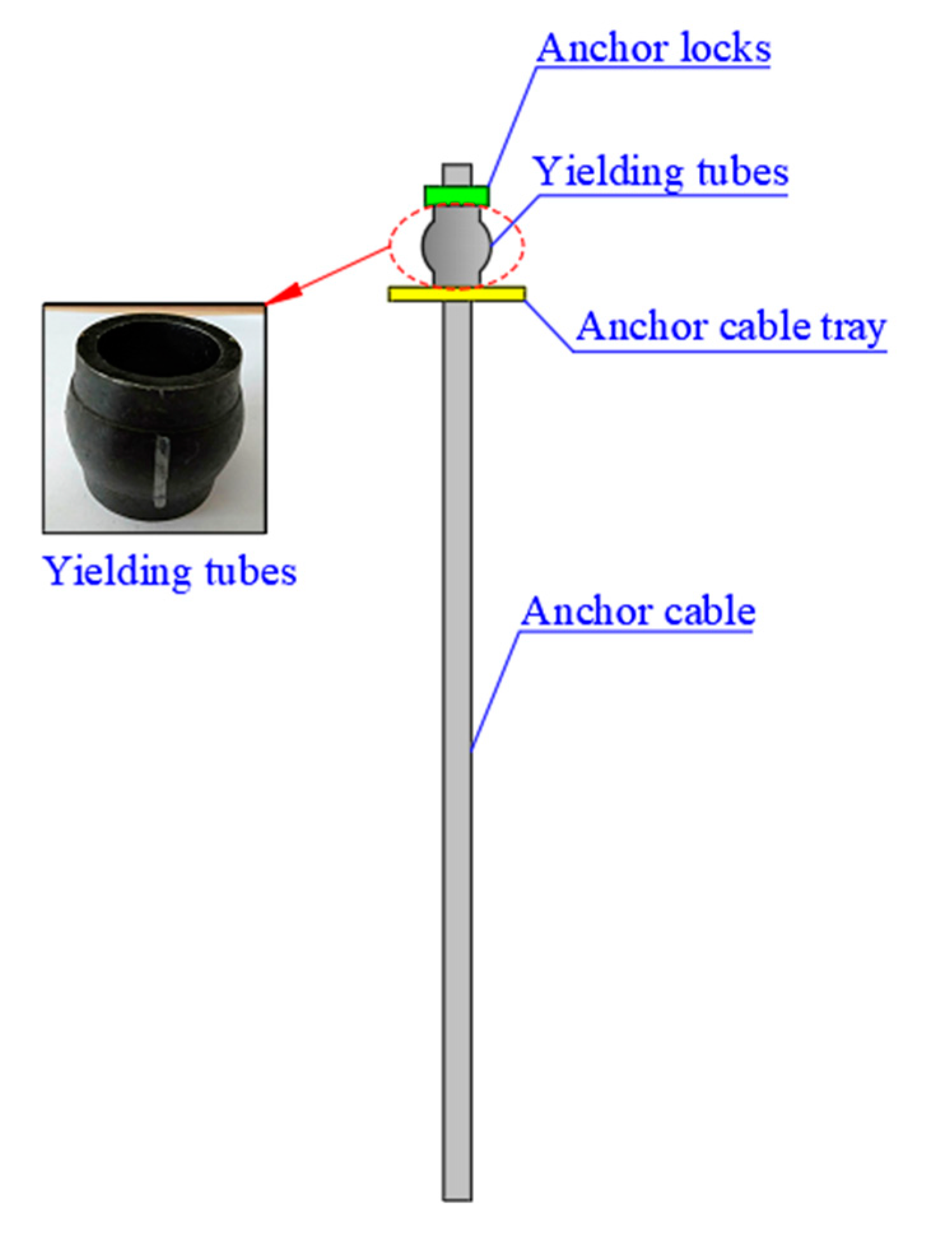
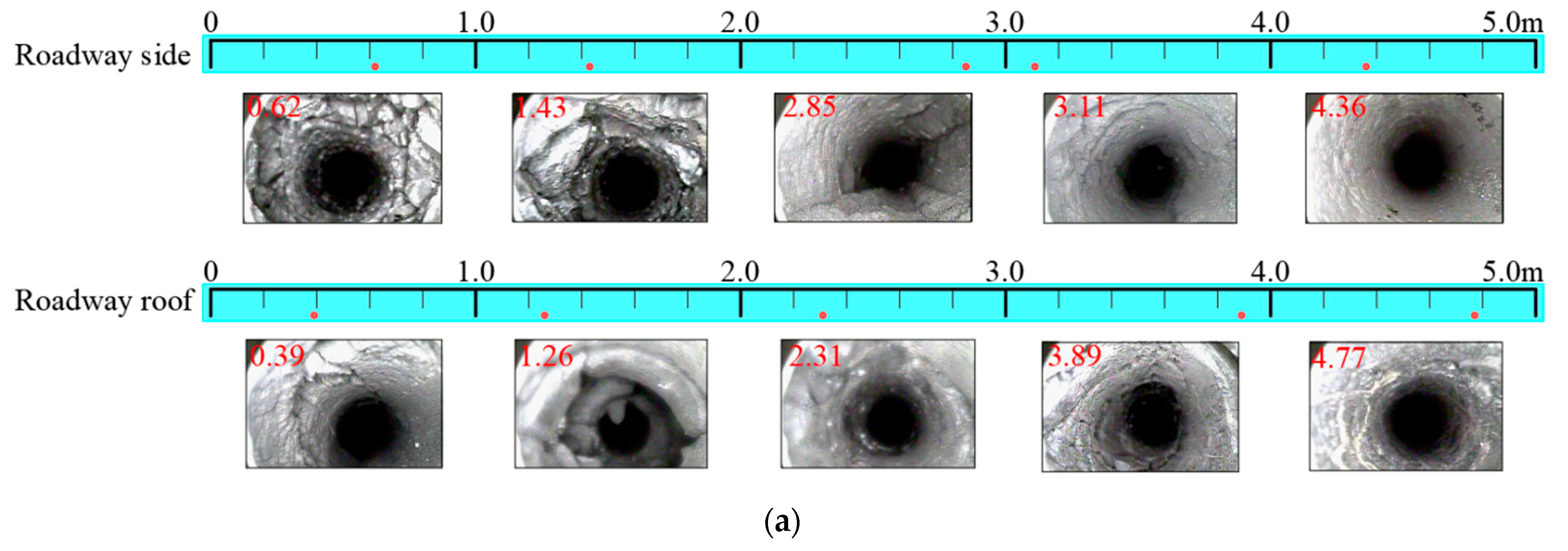
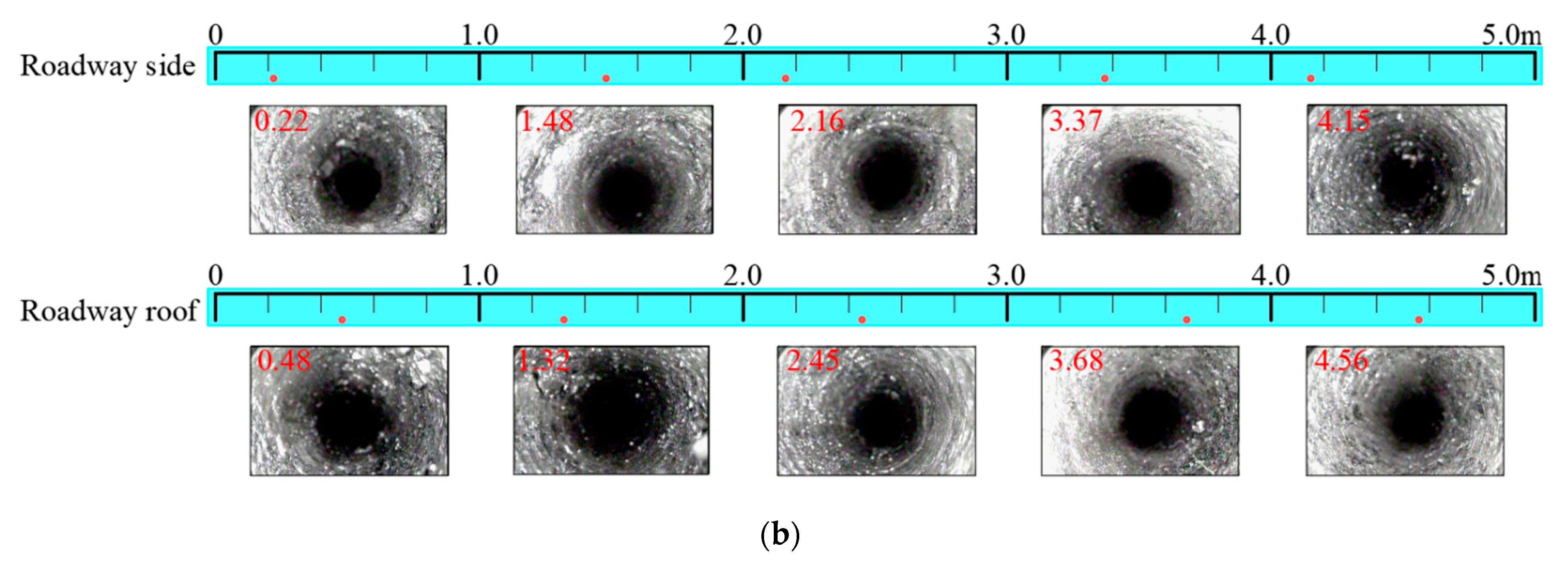
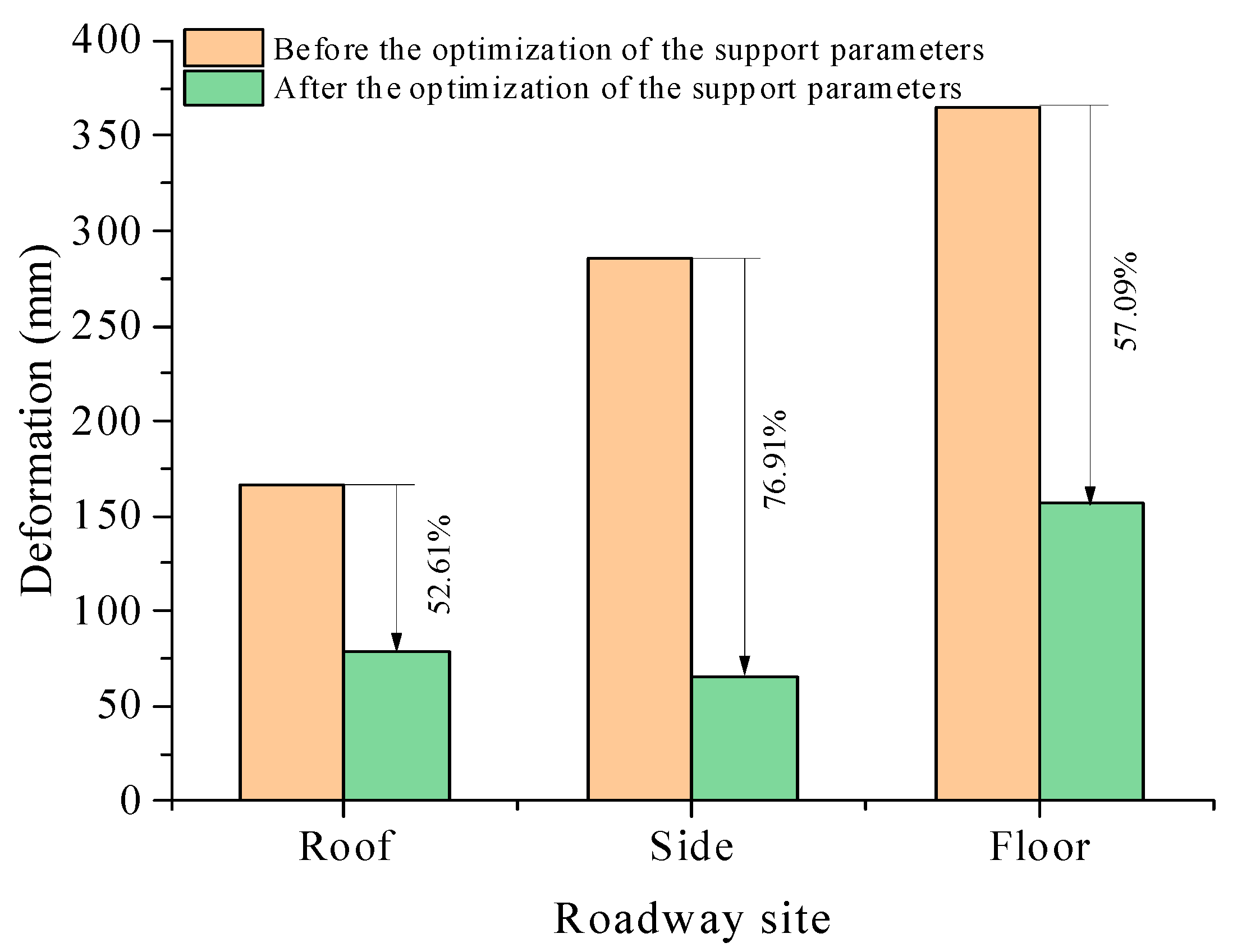
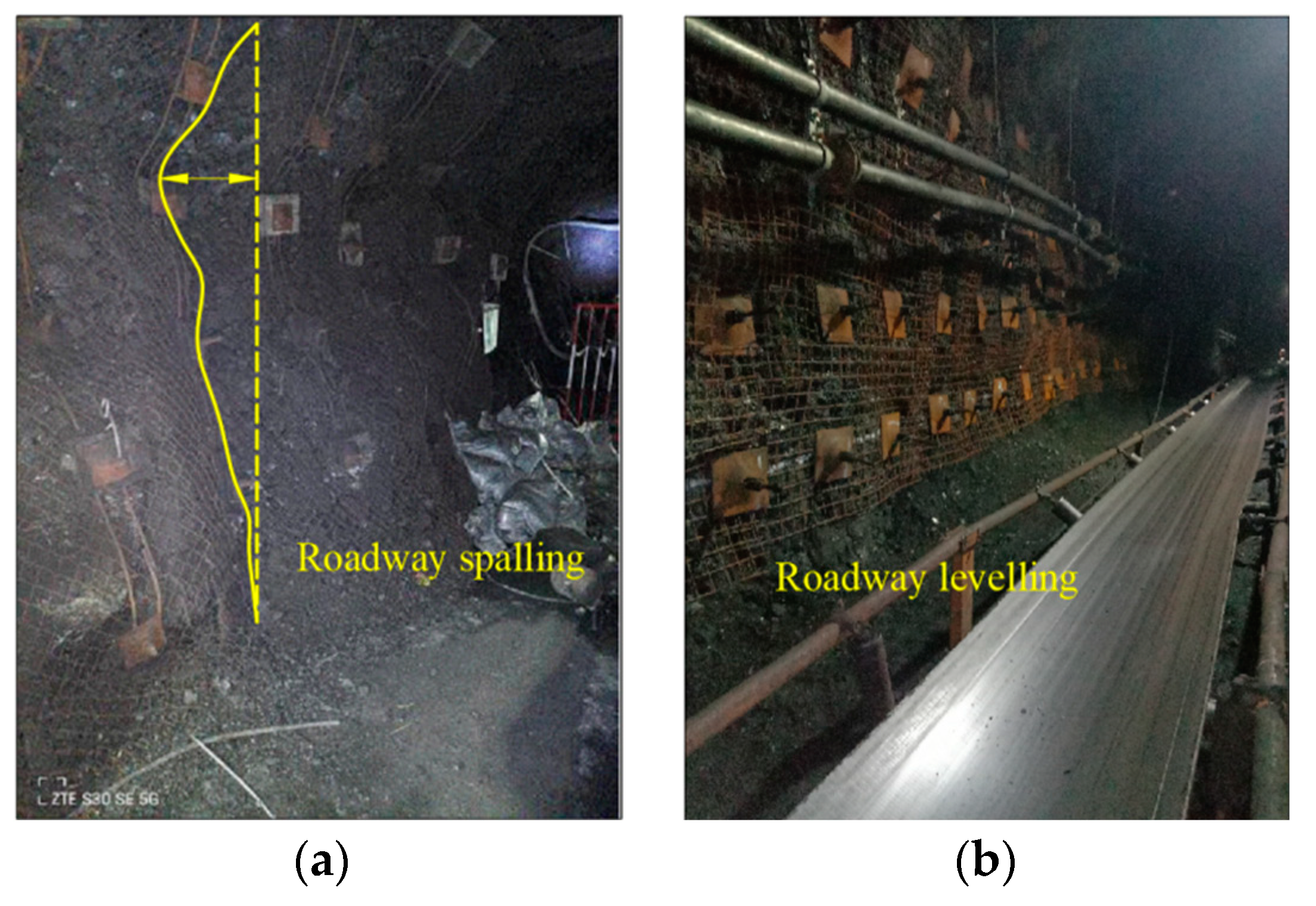
| Lithology | ρ (kg/m3) | E (GPa) | c (MPa) | θ (°) | σt (MPa) |
|---|---|---|---|---|---|
| Mudstone | 2461 | 8.75 | 1.20 | 30.15 | 0.61 |
| Fine sandstone | 2873 | 33.41 | 3.20 | 42.12 | 1.29 |
| Coarse sandstone | 2460 | 19.53 | 3.75 | 38.04 | 1.84 |
| Coal | 1380 | 5.31 | 1.05 | 26.08 | 0.15 |
Publisher’s Note: MDPI stays neutral with regard to jurisdictional claims in published maps and institutional affiliations. |
© 2022 by the authors. Licensee MDPI, Basel, Switzerland. This article is an open access article distributed under the terms and conditions of the Creative Commons Attribution (CC BY) license (https://creativecommons.org/licenses/by/4.0/).
Share and Cite
Xu, D.; Gao, M.; Yu, X. Dynamic Response Characteristics of Roadway Surrounding Rock and the Support System and Rock Burst Prevention Technology for Coal Mines. Energies 2022, 15, 8662. https://doi.org/10.3390/en15228662
Xu D, Gao M, Yu X. Dynamic Response Characteristics of Roadway Surrounding Rock and the Support System and Rock Burst Prevention Technology for Coal Mines. Energies. 2022; 15(22):8662. https://doi.org/10.3390/en15228662
Chicago/Turabian StyleXu, Dong, Mingshi Gao, and Xin Yu. 2022. "Dynamic Response Characteristics of Roadway Surrounding Rock and the Support System and Rock Burst Prevention Technology for Coal Mines" Energies 15, no. 22: 8662. https://doi.org/10.3390/en15228662
APA StyleXu, D., Gao, M., & Yu, X. (2022). Dynamic Response Characteristics of Roadway Surrounding Rock and the Support System and Rock Burst Prevention Technology for Coal Mines. Energies, 15(22), 8662. https://doi.org/10.3390/en15228662







